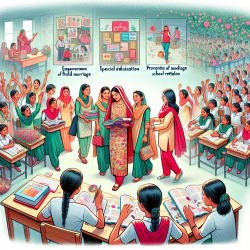Empowering Girls: The Samata Study's Impact on Education and Beyond
In the heart of northern Karnataka, India, a transformative initiative is taking place to support adolescent girls in staying in school, reducing child marriage, and preventing entry into sex work. The Samata study, a cluster-randomized controlled trial, aims to address these pressing issues by implementing a comprehensive, multi-level intervention. This blog explores the key findings and implications of the Samata study, providing insights for practitioners looking to enhance their skills and impact in similar contexts.
Understanding the Samata Study
The Samata study targets low-caste adolescent girls in the Bijapur and Bagalkot districts of northern Karnataka. These regions face high rates of poverty, unemployment, and illiteracy, making girls particularly vulnerable to school dropout, early marriage, and entry into sex work. The study's primary goal is to improve the quality of life for these girls by supporting their entry into and retention in secondary education, delaying marriage, and preventing entry into sex work.
Key Components of the Intervention
- Community Engagement: The intervention engages key stakeholders, including low-caste girls and their families, adolescent boys, village communities, schools, and local government officials. This comprehensive approach aims to change social norms regarding gender, child marriage, and girls' education.
- Educational Support: The study links low-caste families to government schemes providing scholarships, bicycles, and other incentives to support girls' retention in school. Special tutoring sessions and life skills training are also offered to help girls catch up academically and develop leadership skills.
- Gender Norms and Empowerment: Programs like "Parivartan," a sports-based life-skills and empowerment initiative, encourage critical reflection on gender norms and attitudes towards violence against women.
Implications for Practitioners
For practitioners working in education, health, and social development, the Samata study offers valuable insights and strategies for addressing structural drivers of vulnerability among adolescent girls. Here are some key takeaways:
- Holistic Approaches: The success of the Samata intervention highlights the importance of addressing multiple factors simultaneously. Practitioners should consider engaging families, communities, and schools to create a supportive environment for girls.
- Focus on Gender Norms: Changing gender norms is crucial for empowering girls and reducing their vulnerability. Practitioners can incorporate gender-focused programs that challenge traditional roles and promote equality.
- Leverage Government Schemes: Collaborating with government programs can provide additional resources and incentives to support girls' education. Practitioners should explore opportunities to link families with available schemes.
Encouraging Further Research
The Samata study is a pioneering effort, but there is still much to learn about the most effective ways to support adolescent girls in vulnerable communities. Practitioners are encouraged to conduct further research and evaluations to build on the findings of the Samata study. By sharing insights and best practices, we can collectively work towards a future where all girls have the opportunity to thrive.
To read the original research paper, please follow this link: Supporting adolescent girls to stay in school, reduce child marriage and reduce entry into sex work as HIV risk prevention in north Karnataka, India: protocol for a cluster randomised controlled trial.










